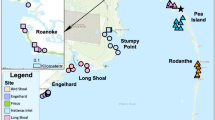Abstract.
Megalopae (postlarvae) of the blue crab Callinectes sapidus Rathbun use flood-tide transport (FTT) for movement into and up estuaries. Since they settle around the time of slack water at the end of flood tide during FTT, it was predicted that orientation toward primary nursery areas of aquatic vegetation occurs at this time. This study tested the hypotheses that megalopae locate nursery areas by swimming upstream in the presence of chemical odors from potential nursery areas and avoid adverse microhabitats by swimming downstream when predator or adverse environmental odors are present. Megalopae were tested in a flume where they were exposed to the sequence of cues mediating FTT (i.e. 2 psu increase in salinity followed by an increase and a decrease in current speed and turbulence). The flume contained odor water either from the developmental area (offshore water), nursery area vegetation (seagrass, Zostera marina; salt marsh cord grass, Spartina alterniflora), predators (fiddler crab, Uca pugilator; mud crab, Panopeus herbstii; grass shrimp, Palaemonetes pugio), or chemicals associated with adverse environments (ammonium). Vertical positions of premolt and intermolt megalopae were similar in water devoid of estuarine chemical cues (offshore water) and water containing seagrass odor. Upstream swimming behavior (orientation) of intermolt megalopae was also similar in these waters. However, there was an ontogenetic behavioral change, as the proportion of premolt megalopae oriented upstream generally increased as the concentration of seagrass and salt marsh cord grass odor increased and as current speed decreased. Upstream orientation of premolt megalopae in response to seagrass odor decreased significantly (i.e. downstream swimming increased) in the presence of odor from U. pugilator, P. pugio, and ammonium, but not from P. herbstii. Thus, the hypothesis was supported. These results suggest premolt megalopae orient toward nursery areas by swimming upstream in response to odors from aquatic vegetation as current speeds decrease at the end of nocturnal flood tides. Moreover, these results also indicate that megalopae may discriminate among microhabitats and avoid adverse settlement habitat, as orientation toward nursery areas is reversed by predator odors and ammonium.
Similar content being viewed by others
Author information
Authors and Affiliations
Additional information
Electronic Publication
Rights and permissions
About this article
Cite this article
Forward, .R., Tankersley, .R., Smith, .K. et al. Effects of chemical cues on orientation of blue crab, Callinectes sapidus, megalopae in flow: implications for location of nursery areas. Marine Biology 142, 747–756 (2003). https://doi.org/10.1007/s00227-002-0966-7
Received:
Accepted:
Issue Date:
DOI: https://doi.org/10.1007/s00227-002-0966-7




